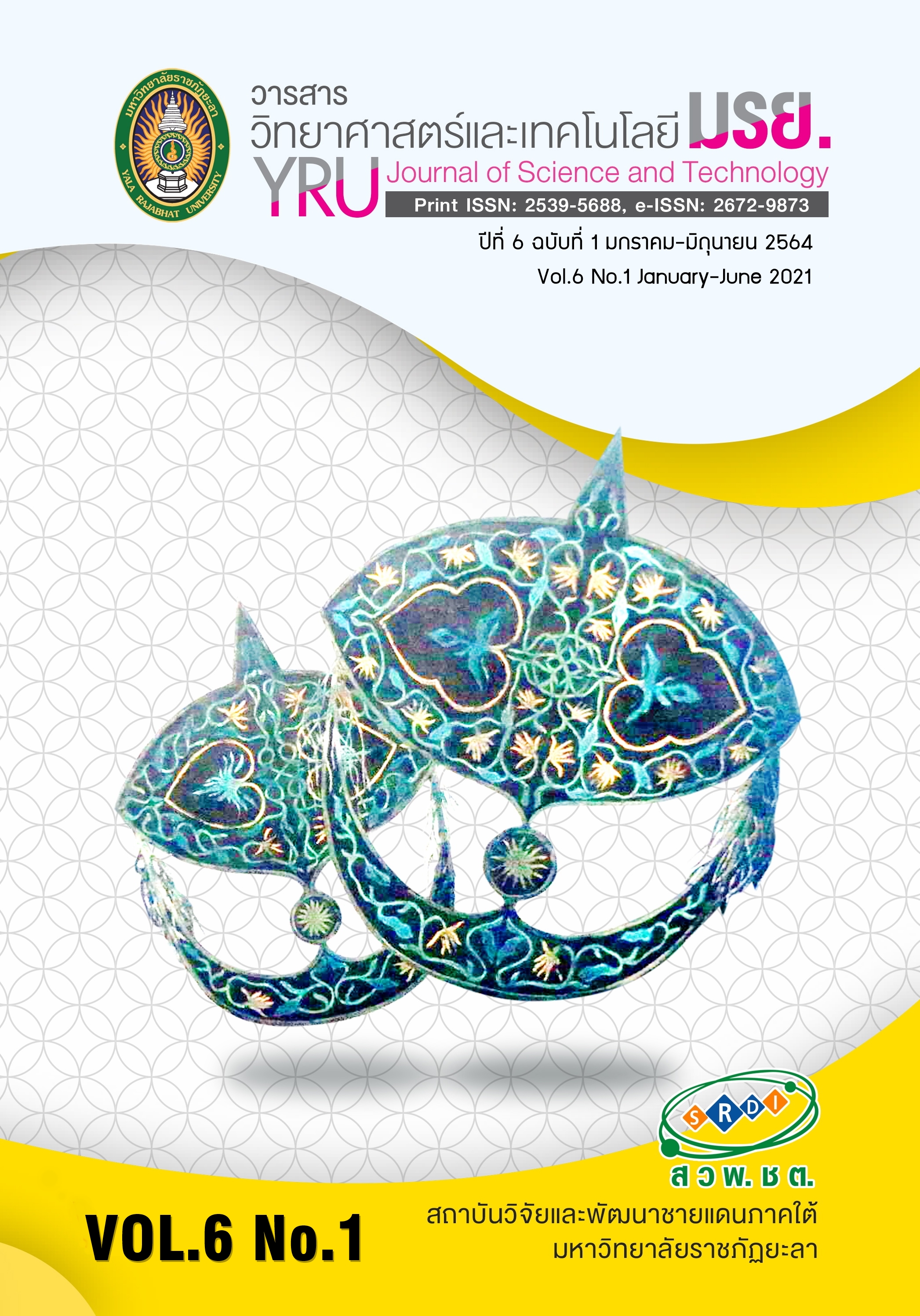Screening of Thermotolerant Amylase-Producing Microorganisms for the Fermented Rice Noodle Wastewater Treatment
Main Article Content
Abstract
Isolation and screening of thermotolerant microorganisms from 18 samples 5 habitats in local places including various areas of rubber factory, charcoal burning plant, rice husk, cow dung and chicken dung that were able to produce amylase used for treating the rice noodle wastewater. The result showed that 15 isolates were thermotolerant bacteria which can grow at 55±2°C but no fungal growth was observed. The qualitative and quantitative of amylase were examined. Six isolates can produce amylase including RF1, RF2, RF4, RF7, RF11 and CBP3. Comparison the enzymatic activity produced by thermotolerant bacteria revealed that thermotolerant bacteria isolate CBP3 could produced the highest activity of amylase ๖(93.5±0.67 U/ml) and specific activity of 80.54 U/ml of protein. Studies on the application of treatment efficiency in rice noodle process effluent in vitro showed that the thermotolerant bacterium isolate CBP3 had BOD and COD removal efficiency of 41.32±0.64 % and 56.23±0.54%. The thermotolerant bacterium isolate CBP3 was identified on the basis of their morphological characteristics showed the CBP3 was classified as Bacillus sp. Therefore, thermotolerant amylase producing bacteria could be apply for wastewater treatment in the fermented rice noodle processing.
Article Details
บทความ ข้อมูล เนื้อหา รูปภาพ ฯลฯ ที่ได้รับการเผยแพร่ในวารสารวิทยาศาสตร์และเทคโนโลยี มรย. นี้ ถือเป็นลิขสิทธิ์ของวารสารวิทยาศาสตร์และเทคโนโลยี มรย. หากบุคคลหรือหน่วยงานใดต้องการนำทั้งหมดหรือส่วนหนึ่งส่วนใดไปเผยแพร่ต่อหรือกระทำการใดๆ จะต้องได้รับอนุญาตเป็นลายลักษณ์อักษรจากวารสารวิทยาศาสตร์และเทคโนโลยี มรย. ก่อนเท่านั้น
References
Adedire, O., Ogundipe, W. & Farinu, A. (2013). Studies on crude thermostable amylase produced by
Bacillus spp. isolated from Starch Waste. International Journal of Science and Research. 2(4),
-400.
Ahirwar S., Soni, H., Prajapati, B.P. & Kango, N. (2017). Isolation and screening of thermophilic and
thermotolerant fungi for production of hemicellulases from heated environments. Mycology.
(3), 125-134.
Annamalai N., Thavasi R., Vijayalakshmi S. & Balasubramanian T. (2011). Extraction, purification and
characterization of thermostable, alkaline tolerant a-Amylase from Bacillus cereus. Indian Journal of Microbiology. 51(4), 424–429.
APHA, AWWA & WEF. (2017). Standard Method for the Examination of Water and Wastewater (23rd)
ed. N. Y. : American Public Health Association.
Ashwini K., Gaurav K., Karthik L., & Bhaskara Rao K.V. (2011). Optimization, production and partial
purification of extracellular α-amylase from Bacillus sp. marini. Archives of Applied Science
Research. 3(1), 33-42.
Langarica-Fuentes, A., Handley, P.S., Houliden, A.G.F. & Robson, G.D. (2014). An investigation of the
biodiversity of thermophilic and thermotolerant fungal species in composts using culture-based and molecular techniques. Fungal Ecology, 11, 132-144.
Jijai, S. & Siripatana, C. (2016). Biogas production by co-digestion of chicken manure with Thai rice
noodle wastewater. Present to Yala Rajabhat University. (in Thai)
Lowry, O.H., Rossebrougggh, N.J., Farr,A.L.and Randall, R.J. (1951). Protein measurement
with the Folin phenol reagent. J. Biol. Chem. 193, 265-276.
Mienda, B.S. & Shamsir, M.S. (2013). Thermotolerant microorganisms in consolidated bioprocessing for
ethanol production: A review. Research in Biotechnology, 4(4), 01-06.
Miller, G.L. (1959). Use of dinitrosalicylic acid reagent for determination of reducing sugar. Anal Chem
,426–429
Msarah, M.J., Ibrahim, I., Hamid, A.A. & Aqma, W. S. (2020). Optimization and production of alpha amylase
from thermophilic Bacillus spp. and its application in food waste biodegradation. Heliyon, 6, 1-8.
Naveena, V. & Joy, P. P. (2014). Microbiology Laboratory Manual. Kerala : Pineapple Research Station
(Kerala Agricultural University)
Paul, D.V., George, M.G,, Dorothy, J., Noel, R.K., Wolfgang, L., Fred, A.R., Karl-Heinz, S. & William, B.W.
(2009).Bergey's Manual of Systematic Bacteriology (2nd ed). USA: Springer Science+Business
Media.
Pratum, C. (2014). Treatment of Traditional Thai-Fermented Rice Noodle (Khanomjeen) plant
Wastewater by Effective Microorganism Together with Natural Treatment. Ph.D thesis,
Environmental Science, Kasetsart University. (in Thai)
Pratum, C. (2017). Influence of high organic substances concentrations in fermented rice noodle
(Khanomjeen) factory wastewater on efficiency wastewater treatment of Vetiveria Zizanioides Nash. and Cyperus Corymbosus Rottb. Journal of Science and Technology Mahasarakham University, 36(3). (in Thai)
Prasertsan, P. & Binmaeil, H. (2018). Treatment of palm oil mill effluent by thermotolerant polymer-
producing fungi. Journal of Water and Environment Technology, 16(3), 127–137.
Sani, R.K & Krishnaraj, R.N. (2017). Extremophilic enzymatic processing of lignocellulosic feedstocks to
bioenergy: Recent advances in extremophilic α-amylases. Rapid City, South Dakota, USA. Springer International Publishing AG 2017.
Sreelatha, B., Priya, A.S & Girisham, S. (2013). Incidence of thermophilic fungi in different dung samples
of warangal district of AP. International Journal of Pharmacy and Biological Sciences, 3(2),
-359.
Sharma, P., Gupta, S., Sourirajan, A. & Dev, K. (2015). Characterization of extracellular thermophilic
amylase from Geobacillus sp. isolated from Tattapani hot spring of Himachal Pradesh,
India. Current Biotechnology, 4(2),1-8.
Yeesang, J. Yemsuan S., & Kaewpuk, W. (2015). The utilization of wastewater from fermented rice noodle
factories in Prong MaDua Community, Amphoe Mueang, Nakhon Patthom for Spirulina sp. Area Based Development Research Journal, 7(4). (in Thai)


